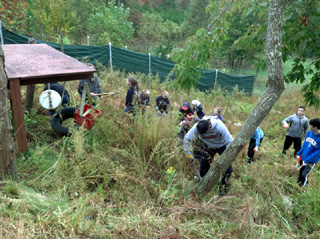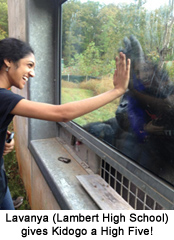 Dewar Wildlife has a strong commitment
to education and conservation. If we do not educate and introduce young
people to all the magnificent creatures on this planet, there will be
little hope for their survival over the long term. Native American Indians
had it right when they said: Treat the earth well: it was not given to
you by your parents, it was loaned to you by your children. That
statement helps remind
us that nature's gifts are not ours to do with as we please, but rather we
should act as stewards for the next generation so they can enjoy the
earth's natural wealth as well. Dewar Wildlife has a strong commitment
to education and conservation. If we do not educate and introduce young
people to all the magnificent creatures on this planet, there will be
little hope for their survival over the long term. Native American Indians
had it right when they said: Treat the earth well: it was not given to
you by your parents, it was loaned to you by your children. That
statement helps remind
us that nature's gifts are not ours to do with as we please, but rather we
should act as stewards for the next generation so they can enjoy the
earth's natural wealth as well.
Our focus is on Gorillas - certainly one of nature's
most magnificent creatures. They are highly endangered, and only by caring
about them can we ensure their survival.
 If you are interested in having your school group visit
Dewar Wildlife, please contact us and we will
provide your group with a unique and educational experience that will enrich
their lives as well as impart valuable knowledge about these magnificent
creatures. If you are interested in having your school group visit
Dewar Wildlife, please contact us and we will
provide your group with a unique and educational experience that will enrich
their lives as well as impart valuable knowledge about these magnificent
creatures.
 We also encourage school groups to have an overnight
outing at Dewar Wildlife. We have a fire ring which works well for
a night time cook-out and students can use sleeping bags inside unoccupied
buildings - even inside cages(!), or they can pitch tents or hammocks and
sleep outside if the weather is good. Restroom and showers are available
in a nearby building to make it a more pleasant experience. We also encourage school groups to have an overnight
outing at Dewar Wildlife. We have a fire ring which works well for
a night time cook-out and students can use sleeping bags inside unoccupied
buildings - even inside cages(!), or they can pitch tents or hammocks and
sleep outside if the weather is good. Restroom and showers are available
in a nearby building to make it a more pleasant experience.
And the next morning, we put everyone to work, helping out with the
maintenance of the gorilla habitat, the support buildings and anything
else that needs to be done at the facility.
Some important Facts about
Gorillas:
Where are
they?
- Gorillas live in Africa with the Western Gorilla
living in West Central Africa, and the Eastern Gorilla in East Central
Africa.
- Of the various sub-species of gorillas, only the
Western lowland gorilla is typically seen by zoo visitors (although
there are a few Eastern Gorillas in Europe, and one Cross River gorilla
in an African zoo).
- Gorillas are highly endangered. In the wild, the
numbers of gorillas are both disputed and rapidly changing. But as a
general guide (and please don't use these figures without mentioning
that they are somewhat speculative!), there are around 100,000+ western
Lowland Gorillas, a few hundred Cross River gorillas, and several
hundred each of Mountain, Bwindi gorillas with perhaps a few thousand
Eastern lowland gorillas (although this number has been rapidly
diminishing in the past two decades).
- There are some 850 or so gorillas in conventional
zoo settings, with possibly 2-3 times that number in
private/undocumented/inappropriate captive settings. The DWT website is
pleased to house Jim
Davis's unofficial Gorilla Stud book which is kept up to date and
maintains records on some 2,100 gorillas that are alive or have lived in
Zoo settings.
General facts
about Gorillas
- Gorillas are highly intelligent creatures - many
cognition researchers peg their intelligence as close to that of a 3-4
year old child.
- Gorillas are not naturally aggressive - in spite
of the ferocious appearance that Hollywood attributes to gorillas, they
are in fact surprisingly gentle creatures given their strength and aggression is the exception,
not the rule. When gorillas do fight (over a female, or to protect their
troop) as much attention is paid to bluffing as actually coming to
blows.
- Gorillas are vegetarians - in the wild, their
diet is almost exclusively based on fruits and vegetables
- There are different species and sub-species of
gorillas and while debate continues as to whether the Bwindi population
constitutes a separate sub-species, as of 2012, the consensus appears to
be as follows:
|
Species |
|
Sub-Species |
| |
|
|
|
Western Gorilla (Gorilla gorilla) |
|
Western
Lowland gorilla (Gorilla gorilla gorilla) |
| |
Cross
River gorilla (Gorilla gorilla diehli) |
| |
|
|
|
Eastern Gorilla (Gorilla beringei) |
|
Mountain
gorilla (Gorilla beringei beringei) |
| |
Eastern
lowland gorilla (Gorilla beringei graueri) |
| |
Bwindi
gorilla (Gorilla beringei bwindi) |
- Adult male gorillas are referred to as
Silverbacks due to the color of the fur on their backs.
- Gorillas are the largest living primate and are
typically around 5' 6" (1.67m) when upright, and about 4' 6" (1.37m) in
their normal position on all fours and weigh around 325-475 lbs.
(147-215kg). Females are smaller, weighing around 150-250 lbs.
(68-113kg).
- Gorillas have large arm spans - some have been
measured at over 9' (2.75m).
- Gorillas usually walk on their knuckles (Knuckle
Walking) although they do sometimes walk or run bipedally (see the
video section under Photos to see the video of one of Oliver's first
days out where he runs bipedally).
- The oldest known gorilla as of November2013 (and
also the first gorilla born in captivity) is 56 years old. Colo will be
57 on December 22, 2013 - and that would be a new record for a gorilla.
As with humans, female gorillas tend to outlive their male counterparts.
In the wild, the usual life-expectancy is around 30-35 years, with
gorillas in zoos typically living some 5-10 years more than that
(probably due to good medical care and regular diet).
- Gorillas live in groups, usually headed by a
single adult male, with several females and juveniles. As younger males
mature, they will leave the group and either go off to find females to
form their own group or form a bachelor group with other males.
- At night, gorillas build nests to sleep in, but
rarely ever use them for more than one night.
- Not all gorillas look the same! If you look at
the nose, you will see that there is a lot of variation and in fact that
is the best way to distinguish gorillas.
- Gorillas remember people. There have been several
cases of gorillas finally seeing keepers after an absence of a decade or
more that have shown unmistakable signs of recognition.
- Gorillas exhibit many human behaviors and
emotions - people are often surprised to find that they have a sense of
humor and are often more curious about us than we are of them.
- Unlike Chimpanzees (which uninformed people often
confuse with gorillas), gorillas rarely vocalize. If upset, they may
cough as a warning or threat or if very upset, bark loudly. When happy,
Gorillas can emit a wonderful low, throaty rumble that tells you they
are enjoying some food or special company.
|


 Dewar Wildlife has a strong commitment
to education and conservation. If we do not educate and introduce young
people to all the magnificent creatures on this planet, there will be
little hope for their survival over the long term. Native American Indians
had it right when they said: Treat the earth well: it was not given to
you by your parents, it was loaned to you by your children. That
statement helps remind
us that nature's gifts are not ours to do with as we please, but rather we
should act as stewards for the next generation so they can enjoy the
earth's natural wealth as well.
Dewar Wildlife has a strong commitment
to education and conservation. If we do not educate and introduce young
people to all the magnificent creatures on this planet, there will be
little hope for their survival over the long term. Native American Indians
had it right when they said: Treat the earth well: it was not given to
you by your parents, it was loaned to you by your children. That
statement helps remind
us that nature's gifts are not ours to do with as we please, but rather we
should act as stewards for the next generation so they can enjoy the
earth's natural wealth as well.
 We also encourage school groups to have an overnight
outing at Dewar Wildlife. We have a fire ring which works well for
a night time cook-out and students can use sleeping bags inside unoccupied
buildings - even inside cages(!), or they can pitch tents or hammocks and
sleep outside if the weather is good. Restroom and showers are available
in a nearby building to make it a more pleasant experience.
We also encourage school groups to have an overnight
outing at Dewar Wildlife. We have a fire ring which works well for
a night time cook-out and students can use sleeping bags inside unoccupied
buildings - even inside cages(!), or they can pitch tents or hammocks and
sleep outside if the weather is good. Restroom and showers are available
in a nearby building to make it a more pleasant experience.